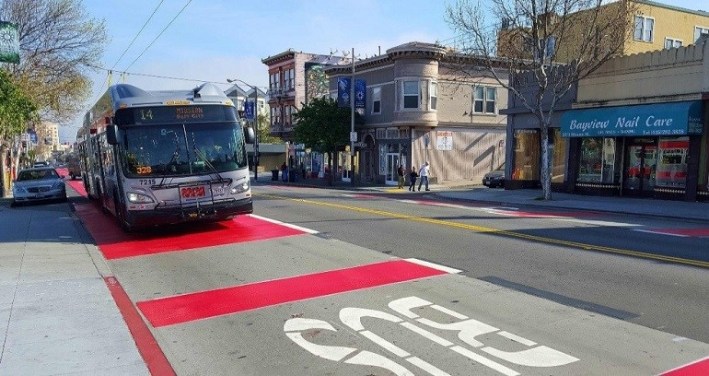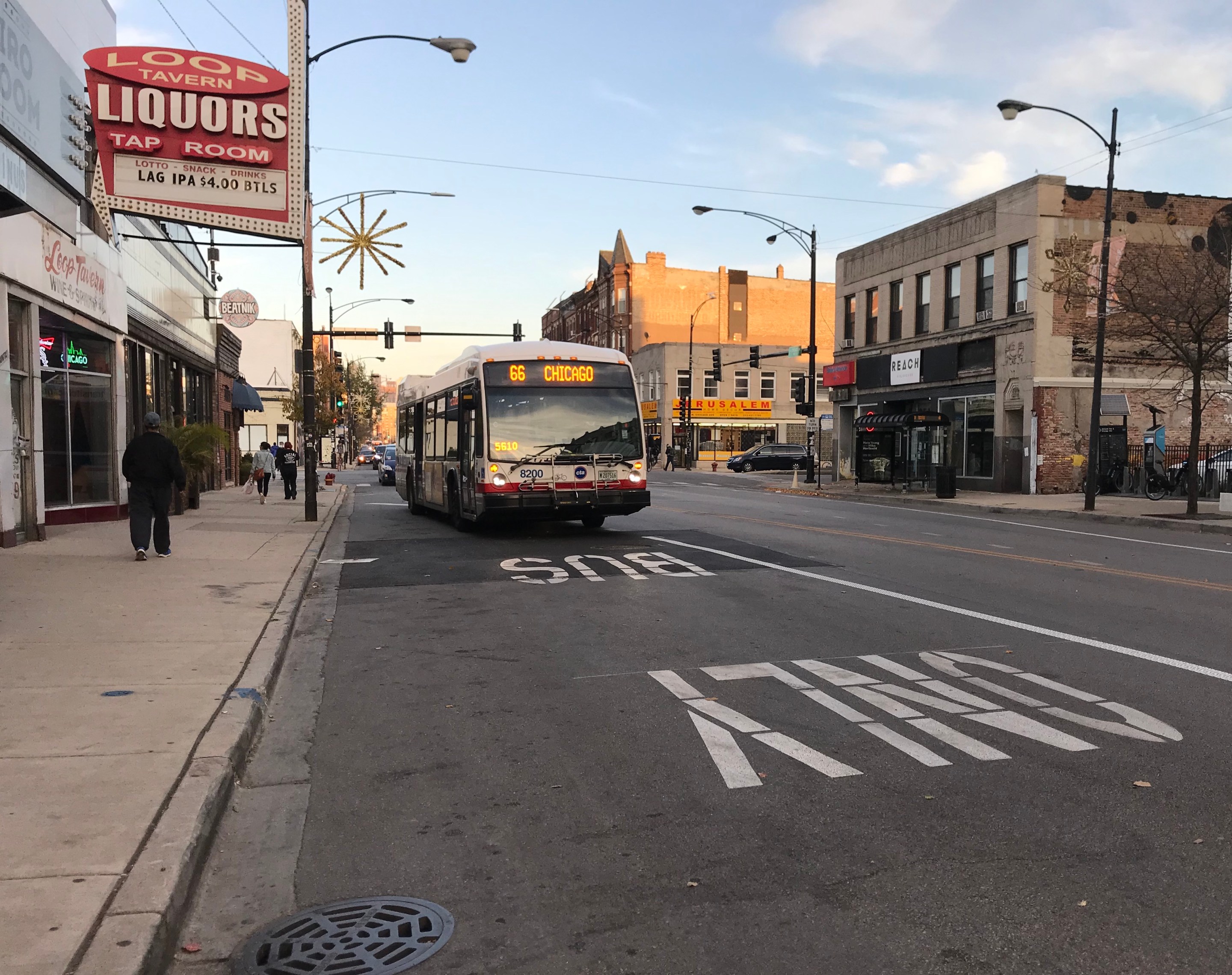TransitCenter, a foundation that works to improve transit in the United States, recently hosted the talk “Bus Lanes are Essential: Speeding Transit During COVID.” The panel included Mayor Lori Lightfoot’s transportation policy advisor Maulik Vaishnav, as well as Kristiana Lachiusa, community engagement manager for Boston's LivableStreets Alliance, and Michael Rhodes, transit priority team lead for San Francisco Municipal Transportation Agency. The discussion was moderated by Hayley Richardson, senior communications lead for TransitCenter. (The foundation is a Streetsblog Chicago funder.)
Richardson started off by noting that “buses have been the work horses of the pandemic,” given that buses, which are more likely to be used by essential workers, have seen less ridership loss than rail in cities like Chicago, where the 'L' serves a higher percentage of white-collar employees currently working from home. Bus-only lanes prevent buses from being bogged down in private vehicle-generated traffic jams and allow agencies to run more buses, which is important given the need to avoid crowding and enable social distancing.
Lachiusa reported that Boston and its surrounding suburbs have added 14 miles of bus lanes during the pandemic. In contrast Chicago, with about four times the population, has only added 7.6 miles during the quarantine. Rhodes said San Francisco has only striped three miles of pandemic bus lanes so far, but the city's goal is to build a 70-mile network.

Richardson asked the panelists how COVID-19 has impacted transit ridership in their cities. Rhodes said public transportation use in SF is down overall for a variety of reasons: People have fewer reasons to make trips, and Muni Metro light rail and subway service have been shut down due to infrastructure problems. But SFMTA is also struggling to add enough service to some bus routes to allow for social distancing, given the higher demand for buses as a result of the Muni shutdown.
Vaishnav said the CTA generally provided 1.5-1.6 million daily trips before the pandemic, evenly split between buses and the 'L'. Rail ridership has dropped by 80 percent during the crisis while bus ridership has remained the same overall. He added that while Chicago was partly reopened this summer, ridership increased by 50 percent.
Lachiusa cited TransitCenter’s report that showed Black, Brown, and lower-income residents were more likely to continue to rely on transit for their mobility needs during the crisis. She made the case for transit agencies continuing to implement bus lanes in the face of budget cuts.
Richardson asked the panelists how COVID has changed the way bus lanes are implemented in their cities. Rhodes said the speed at which San Francisco is rolling out bus-only lanes has increased, “What normally might take two years from concept to implementation is now happening in a matter of months.” San Francisco is also foregoing red paint and focusing more on projects that can easily be implemented and adjusted.
Lachiusa cited the Massachusetts Department of Transportation's new funding program for sustainable transportation infrastructure as an incentive for municipalities to build bus lanes. There had already been studies identifying where bus slowdowns happen, and who is disproportionately burdened with lengthier commutes, and the pandemic further highlighted the need to address these issues.
The moderator noted that before the pandemic Chicago had only a smattering of bus lanes, mostly along the Loop Link and Jeffery Jump corridors, and asked Vaishnav what shifted the institutional urgency for implementing pop-up bus-only lanes. Vaishnav pointed to the Lightfoot administration’s concern about car traffic rebounding from the quarantine faster than transit ridership, and noted that Chicago Avenue and 79th Street, which recently got pop-up lanes, had already been identified as routes for bus-only lane treatment.
Vaishnav acknowledged out that, unlike Chicago's permanent bus lanes, the pop-up lanes do not have red paint, but argued that the white street markings are enough to create a “behavioral change” in drivers. My recent experience riding the 79th Street bus contradicts this narrative that painting “Bus Only lane” on a street is enough to change driver behavior and truly speed up bus service.

The panelists were then invited to discuss approaches to community engagement during a pandemic. Rhodes said the pandemic highlighted what SFMTA’s bus service could look like without traffic obstructions and showed which routes and intersections had been most impacted by congestion. Being able to point to potential travel time savings was very helpful in making the case for reallocating road space during community outreach. The temporary, easily reversible nature of these changes also helped prevent push-back. Online open houses, direct outreach to stakeholders, phone calls to businesses, posters on the streets, text message surveys, and door-to-door outreach were part of the SFMTA outreach strategy.
Lachiusa mentioned mailings and in-person outreach as being key outreach strategies in the Boston area.
Vaishnav said the the Active Transportation Alliance helped the Chicago Department of Transportation and the CTA build support for the lanes, and meetings with aldermen and feedback from bus drivers and community groups about bus crowding were crucial components to the rollout of the pandemic bus-only lanes.
Richard asked how the bus lanes are performing in the three cities. Rhodes said the faster bus travel times they saw during San Francisco's Shelter in Place order, when car traffic was lighter, have stayed about the same as traffic has increased, thanks in part to the emergency transit lanes.

Vaishnav said the CTA will be looking at travel times and the Lightfoot administration is interested in reliability as well.
Lachiusa said the bus lanes have had a traffic calming effect in Boston: Car speeds have decreased along the corridors where bus lanes have been installed.
The conversation then shifted to how to make these pop-up lanes permanent. Rhodes stated that the plan for many of the lanes is to “make them permanent in some form.” Evaluation has already begun on the lanes and there are plans to do outreach about making them permanent. “Since people have been able to see them in action, it allows us to have a more effective outreach process.” He also anticipates the lanes being seen as an economic recovery tool once the city begins to fully reopen.
Lachiusa said all the lanes in the Boston area will be permanent.
Vaishnav pointed to Chicago Metropolitan Agency for Planning funds and Mayor Lightfoot’s capital improvement plan that will ensure $5 million dollars a year is available for bus lane and bike lane improvements.
Lastly, panelists were asked about how COVID-19 has increased the urgency of providing better bus service and helped overcome institutional inertia. Lachiusa said that in the past Boston-area transit agencies made changes each quarter, but during the swiftly changing pandemic situation agencies have been making weekly changes based on feedback from riders and analysis.
I loved the first line of Vaishnav response, “This moment has made it abundantly clear that we don’t need to do more studies or analysis. We can’t forget the folks who don’t own cars who make our cities more liveable and the fact that these people rely on buses, especially. It would be a huge loss if local governments are forced to cut these services that allow people to make essential trips.”
Rhodes pointed to the speed at which SFMTA responded to a reduction in workers. He also discussed SFMTA’s equity strategy. If service is cut, the agency tries to do so in a way that reduces the impact on riders who are low-income and marginalized. I would love to see the Chicago area’s transit agencies develop and implement an equity strategy as well. In many ways this current moment necessitates it.
If you’d like to watch this discussion, you can check out the recording on TransitCenter’s website.





